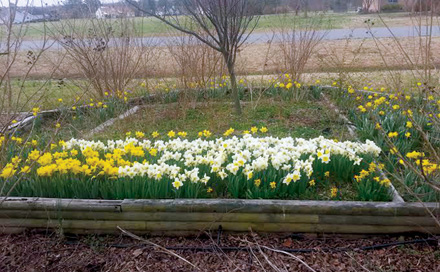Planting Bulbs in Winter

The anticipation was palpable and it had nothing to do with Christmas. My brother in Virginia was doing some garden remodeling and asked if he could send back some of the daffodil bulbs I had gifted him over the years. That way the bulbs could visit “home” for a couple of years and once his new flower beds were ready, the bulbs could make the trip back to their new garden spot, maybe with me in tow.
Need you even ask, was my original answer. Actually I brought a suitcase full back when I visited him earlier and already had those settled in. During that gardening time together, we had discussed whether I should set up special garden beds for his bulbs.
After much thought, my brother said no, “I’ll just go shopping when I’m ready,” meaning he will browse my garden and pick out the bulbs he wants back when his new flower beds are finished.
I didn’t hear much for several weeks. Then my sister-in-law broke the news that two boxes were heading my way, and they weighed 70 lbs.
How many bulbs in 70 lbs, I wondered aloud to local friends. No one seemed to know including my gardening friend Tom. “Oh, you’re in trouble now,” was his only answer so I decided not to worry about it until the boxes arrived.
The two boxes were intact and undamaged so I peeked inside to find several white bags, each holding different types of daffodil bulbs. Plastic tags were in the bags suggesting the type of bulb but my brother said no guarantees since they were mixed in the flower beds. Good chance that some are tete a tete small yellow daffodils and the large King Alfred yellow daffodils, which I gave to him in years past. No telling what was in the other bags.
In all of the bags with bulbs, the bulbs did not look like bulbs one buys in fall for planting. These have green shoots at one end and roots at the other, looking like they had been slipped right out of a garden bed in the middle of growing. No time to waste getting these into the ground since the roots are delicate and need to re-establish themselves.
Spring bulbs develop roots in fall and need exposure to cold temperatures from 12 to 16 weeks before blooming. This chilling period kicks bulbs into spring growth.
The existing green tops will die off when cold weather moves in but they will grow again in spring, gathering energy in the bulbs once they sprout again. Some may not bloom this spring if they don’t have enough energy to bloom but they should the second year after enough energy is stored.
To plant, I will add compost to the bottom of the planting holes so the bulb roots will have easy access to nutrients. Once planted, they will also be watered well so they can absorb nearby food in soil, then covered in a good blanket of wood chip mulch and leaves.
Charlotte Ekker Wiggins is a beekeeper, gardener and sometimes cook. Published by El Dorado Springs Sun once in print and online with author’s permission. Copyright 2017, all rights reserved. This column may not be reprinted, republished or otherwise distributed without author’s permission. Contact Charlotte at gardeningcharlotte at gmail dot com.

DAFFODILS IN THE ROUGH – This is my brother’s lovely daffodil bed now dug up and in Missouri waiting to be planted.
 DAFFODILS IN EXILE – Daffodil bulbs settling into their Missouri flower beds for a short visit of a couple of years while their Virginia beds are remodeled. (Photos by Charlotte Ekker Wiggins).
DAFFODILS IN EXILE – Daffodil bulbs settling into their Missouri flower beds for a short visit of a couple of years while their Virginia beds are remodeled. (Photos by Charlotte Ekker Wiggins).



Facebook Comments